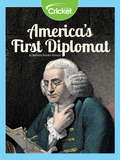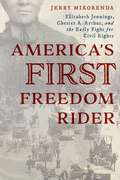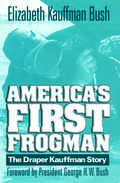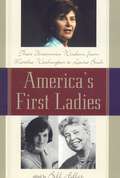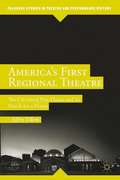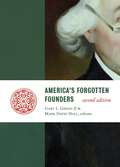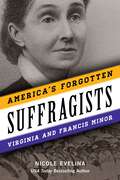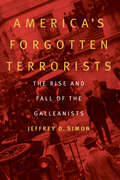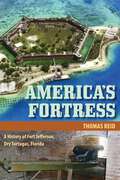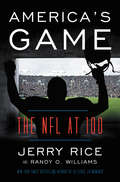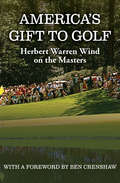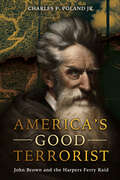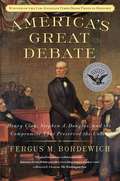- Table View
- List View
America's First Diplomat
by Barbara Brooks SimonsDo you know who Benjamin Franklin is? You might know him as the scientist who discovered electricity by tying a key to a kite during a storm! Did you know he was a founding father of the United States? He made many efforts to the Revolutionary War and the construction of the United States government. Learn about all the political contributions he made that helped create the United States!
America's First Dynasty: The Adamses, 1735-1918
by Richard BrookhiserRichard Brookhiser has won a wide and loyal following for his stylish, pointed, and elegant biographies of George Washington and Alexander Hamilton. In America's First Dynasty,Brookhiser tells the story of America's longest and still greatest dynasty- the Adamses, the only family in our history to play a leading role in American affairs for nearly two centuries. From John, the self-made, tough-minded lawyer who rose to the highest office in the government he helped create; to John Quincy, the child prodigy who grew up amid foreign royalty, followed his father to the White House, and later reinvented himself as a champion of liberty in Congress; to politician and writer Charles Francis, the only well-balanced Adams; to Henry, brilliant scholar and journalist- the Adamses achieved longer-lasting greatness than any other American family. Brookhiser's canvass starts in colonial America, when John Adams had to teach himself the law and ride on horseback for miles to find clients. It does not end until after the Titanic sinks- Henry had booked a room but changed his plans- and World War I begins, with Henry near the action in France. The story of this single family offers a short course in the nation's history, because for nearly two hundred years Adams history was American history. The Adamses were accompanied by an impressive cast of characters, from George Washington and Thomas Jefferson, to Andrew Jackson and Ulysses Grant, to Teddy Roosevelt. America's First Dynasty offers telling portraits of the great men of our past, and many of the women around them. John and Abigail's great love affair was destined to be repeated by their offspring and offspring's offspring. As with any family, there was a darker side to the Adams story: many of its members were abject failures. Alcoholism was a familiar specter, and suicide was not unknown. Only one of the four great Adamses was a kind man and father; the others set standards so impossibly high that few of their children could meet them. Yet despite more than a century of difference from John to Henry, certain Adams traits remained the same. In the story of our first and still-greatest family, we can all see something of our own struggles with family, fate, and history.
America's First Freedom Rider: Elizabeth Jennings, Chester A. Arthur, and the Early Fight for Civil Rights
by Jerry MikorendaIn 1854, traveling was full of danger. Omnibus accidents were commonplace. Pedestrians were regularly attacked by the Five Points&’ gangs. Rival police forces watched and argued over who should help. Pickpockets, drunks and kidnappers were all part of the daily street scene in old New York. Yet somehow, they endured and transformed a trading post into the Empire City. None of this was on Elizabeth Jennings&’s mind as she climbed the platform onto the Chatham Street horsecar. But her destination and that of the country took a sudden turn when the conductor told her to wait for the next car because it had &“her people&” in it. When she refused to step off the bus, she was assaulted by the conductor who was aided by a NY police officer. On February 22, 1855, Elizabeth Jennings v. Third Avenue Rail Road case was settled. Seeking $500 in damages, the jury stunned the courtroom with a $250 verdict in Lizzie&’s favor. Future US president Chester A. Arthur was Jennings attorney and their lives would be forever onward intertwined. This is the story of what happened that day. It&’s also the story of Jennings and Arthur&’s families, the struggle for equality, and race relations. It&’s the history of America at its most despicable and most exhilarating. Yet few historians know of Elizabeth Jennings or the impact she had on desegregating public transit.
America's First Frogman
by Elizabeth Kauffman BushAlthough bad eyesight kept him from receiving a commission in the U.S. Navy when he graduated from the Naval Academy in 1933, Draper Kauffman became a hero of underwater demolition in World War II and went on to a distinguished naval career. Today Admiral Kauffman is remembered as the nation's first frogman and the father of the Navy Seals. His spectacular wartime service disarming enemy bombs, establishing bomb disposal schools, and organizing and leading the Navy's first demolition units is the focus of this biography written by Kauffman's sister. Elizabeth Kauffman Bush, who also is the aunt of President George W. Bush, draws on family papers as well as Navy documents to tell Kauffman's story for the first time. Determined to defend the cause of freedom long before the U.S. ever entered the war, Kauffman was taken prisoner by the Germans as an ambulance driver in France, and after his release joined the Royal Navy to defuse delayed-action bombs during the London blitz. After Pearl Harbor his eyes were deemed adequate and he was given a commission in the U.S. Naval Reserve. With his experience, he was asked to establish an underwater demolition school in Fort Pierce, Florida, where he personally trained men to defuse bombs and neutralize other submerged dangers. His men were sent to demolish the obstacles installed by the Nazis at Normandy, and Kauffman himself led underwater demolition teams in the Pacific at Saipan, Tinian, and Guam and later directed UDT operations at Iwo Jima and Okinawa. His men remember him as an exceptional leader who led by example. He trained and fought alongside them, impervious to danger. Because of the high standards he set for those who became "frogmen,"thousands of American lives were saved in World War II, Korea, and Vietnam. Draper Kauffman's early established UDT traditions of perseverance, teamwork, and a lasting brotherhood of men of extraordinary courage is carried on by Navy Seals. This is his legacy to the U.S. Navy and his country.
America's First Great Depression: Economic Crisis and Political Disorder after the Panic of 1837
by Alasdair RobertsFor a while, it seemed impossible to lose money on real estate. But then the bubble burst. The financial sector was paralyzed and the economy contracted. State and federal governments struggled to pay their domestic and foreign creditors. Washington was incapable of decisive action. The country seethed with political and social unrest. In The First Great Depression, Alasdair Roberts describes how the United States dealt with the economic and political crisis that followed the Panic of 1837. As Roberts shows, the two decades that preceded the Panic had marked a democratic surge in the United States. However, the nation's commitment to democracy was tested severely during this crisis. Foreign lenders questioned whether American politicians could make the unpopular decisions needed on spending and taxing. State and local officials struggled to put down riots and rebellion. A few wondered whether this was the end of America's democratic experiment. Roberts explains how the country's woes were complicated by its dependence on foreign trade and investment, particularly with Britain. Aware of the contemporary relevance of this story, Roberts examines how the country responded to the political and cultural aftershocks of 1837, transforming its political institutions to strike a new balance between liberty and social order, and uneasily coming to terms with its place in the global economy.
America's First Ladies: Their Uncommon Wisdom, from Martha Washington to Laura Bush
by Bill AdlerHere are the personal philosophies, opinions, thoughts, witticisms, and feelings of such upstanding and quintessential Americans as Abigail Adams, Dolly Madison, Eleanor Roosevelt, Jacqueline Kennedy, Nancy Reagan, Barbara Bush, and Hillary Clinton. These women have been more than just wives of American Presidents. Their roles have included everything from negotiating with heads of state to redecorating the White House, from debating political issues to acting as advisors, confidantes, and diplomats.Through statements made during press interviews and in speeches and in writing, these women put into words what might otherwise have remained private: Abigail Adams proves herself to be a pioneer feminist; Eleanor Roosevelt defines life's ultimate success; Lady Bird Johnson recounts a soul-enriching boat ride; and much more. What they have to say about marriage, child-rearing, success, happiness, beauty in the world, education, careers for women, women in politics, relationships, growing old, love, and living life to the fullest is powerful and profound.The pronouncements, pet peeves, gibes, and joys revealed in America's First Ladies add texture to the more secretive administrations, and color to the sterner and more stoic ones.
America's First Regional Theatre
by Jeffrey UllomThe Cleveland Play House has mirrored the achievements and struggles of both the city of Cleveland and the American theatre over the past one hundred years. This book challenges the established history (often put forward by the theatre itself) and long-held assumptions concerning the creation of the institution and its legacy.
America's First Woman Lawyer: The Biography of Myra Bradwell
by Jane M. FriedmanDuring her lifetime, Myra Bradwell (1831-1894) - America's "first" woman lawyer as well as publisher and editor-in-chief of a prestigious legal newspaper - did more to establish and aid the rights of women and other legally handicapped people than any other woman of her day. Her female contemporaries - Susan B. Anthony, Elizabeth Cady Stanton, Lucy Stone - are known to all. Now it is time for Myra Bradwell to assume her rightful place among women's rights leaders of the nineteenth century. With author Jane Friedman's discovery of previously unpublished letters and valuable documents, Bradwell's fascinating story can at last be told.
America's Fiscal Constitution: Its Triumph and Collapse
by Bill WhiteWhat would Washington, Jefferson, Madison, Lincoln, the Roosevelts, Truman, and Eisenhower have done about today's federal debt crisis?America's Fiscal Constitution tells the remarkable story of fiscal heroes who imposed clear limits on the use of federal debt, limits that for two centuries were part of an unwritten constitution. Those national leaders borrowed only for extraordinary purposes and relied on well-defined budget practices to balance federal spending and revenues. That traditional fiscal constitution collapsed in 2001. Afterward-for the first time in history-federal elected officials cut taxes during war, funded permanent new programs entirely with debt, grew dependent on foreign creditors, and claimed that the economy could not thrive without routine federal borrowing.For most of the nation's history, conservatives fought to restrain the growth of government by insisting that new programs be paid for with taxation, while progressives sought to preserve opportunities for people on the way up by balancing budgets. Virtually all mainstream politicians recognized that excessive debt could jeopardize private investment and national independence.With original scholarship and the benefit of experience in finance and public service, Bill White dispels common budget myths and distills practical lessons from the nation's five previous spikes in debt. America's Fiscal Constitution offers an objective and hopeful guide for people trying to make sense of the nation's current, most severe, debt crisis and its impact on their lives and our future.
America's Flag Story
by Karen S. RobbinsThe American flag waves in reverence for many—for the immigrants who came and built a nation with hard work and ingenuity and for all who continue to defend and serve our nation. The verse and artwork resonate with the symbolism that represents the very characteristics of our nation and offers young readers a clear understanding of how one part of our country says so much. The flag represents the freedom, the endurance, and the indomitable courage that makes America the home of the free and brave.
America's Forgotten Colonial History
by Dana HuntleyThis is what we all learned in school: Pilgrims on the Mayflower landed at Plymouth Rock in 1620. They had a rough start, but ultimately made a go of it, made friends with the Indians, and celebrated with a big Thanksgiving dinner. Other uptight religious Puritans followed them and the whole place became New England. There were some Dutch down in New York, and sooner or later William Penn and the Quakers came to build the City of Brotherly Love in Pennsylvania, and finally it was 1776 and time to revolt against King George III and become America. That&’s it. That&’s the narrative of American colonial history known to one and all. Yet there are 150 years – six or seven generations between Plymouth Plantation and the 1770s – that are virtually unknown in our national consciousness and unaccounted for in our American narrative. Who, what, when, where and why people were motivated to make a two-month crossing on the North Atlantic to carve a life in a largely uncharted, inhospitable wilderness? How and why did they build the varied societies that they did here in the New World colonies? How and why did we become America?America&’s Forgotten Colonial History tells that story.
America's Forgotten Founders, second edition (Lives of the Founders)
by Mark David Hall Gary L. GreggBeyond Washington and Jefferson: Ranking the Founders. Even as Americans devour books about our Founding Fathers, the focus seldom extends past a half dozen or so icons—Franklin, Washington, Adams, Jefferson, Madison, Hamilton. Many of the men (and women) who made prodigious contributions to the American founding have been all but forgotten. America's Forgotten Founders corrects this injustice. Editors Gary L. Gregg II and Mark David Hall surveyed forty-five top scholars in history, political science, and law to produce the first-ever ranking of the most neglected contributors to the American Revolution and our constitutional order. This unique book features engaging short biographies of the top ten most important Founders whose contributions are overlooked today: James Wilson, George Mason, Gouverneur Morris, John Jay, Roger Sherman, John Marshall, John Dickinson, Thomas Paine, Patrick Henry, and John Witherspoon. Part of the "Lives of the Founders" series, America's Forgotten Founders reshapes our understanding of America's founding generation.
America's Forgotten Suffragists: Virginia and Francis Minor
by Nicole EvelinaAfter being forgotten for nearly 130 years, the &“Mother of Suffrage in Missouri&” and her husband are finally taking their rightful place in history.St. Louisans Virginia and Francis Minor forever changed the direction of women&’s rights by taking the issue to the Supreme Court for the first and only time in 1875, a feat never eclipsed even by their better-known peers Susan B. Anthony and Elizabeth Cady Stanton. Yet despite a myriad of accomplishments and gaining notoriety in their own time, the Minors&’ names have largely faded from memory. In 1867, Virginia founded the nation&’s first organization solely dedicated to women&’s suffrage—two years before Anthony formed the National Woman&’s Suffrage Association (NWSA). Virginia and Francis were also the brains behind the groundbreaking idea that women were given the right to vote under the Fourteenth Amendment, a philosophy the NWSA adopted for nearly a decade.And their story doesn&’t end there. After the court case, Francis went on to become a prolific writer on women&’s rights and one of the first and strongest male allies of the suffrage movement. Virginia instigated tax revolts across the country and campaigned side-by-side with Anthony for women&’s rights in Missouri, Kansas, and Nebraska. America&’s Forgotten Suffragists: Virginia and Francis Minor is the first biography of these suffrage celebrities who were unique for their time in being jointly dedicated to the cause of female enfranchisement. This book follows their lives from slave-holding Virginians through their highly-lauded civilian work during the Civil War, and into the height of the early suffrage movement to show how two ordinary people of like mind, dedicated to a cause, can change the course of history.
America's Forgotten Terrorists: The Rise and Fall of the Galleanists
by Jeffrey D. SimonThough largely forgotten today, one of the most destructive terrorist groups in the United States was the Galleanists, a fiery band of Italian anarchists active during the early 1900s. In America&’s Forgotten Terrorists, Jeffrey D. Simon shows how alienation and frustration among segments of a community were transformed into a militant extremist movement. Luigi Galleani, a gifted writer and speaker, tapped into widespread disappointment among Italian immigrants concerning their lives in America. Unemployment, low wages, long working hours, discrimination, and a poor quality of life made many Italian immigrants receptive to his words. The Galleanists introduced terrorist tactics and strategies that are still used today: they were the first group to send package bombs across the country and to exploit the media for their own advantage. One of their members is also suspected of launching the first vehicle bomb in the United States in 1920, considered the worst act of domestic terrorism until the 1995 Oklahoma City bombing. The story of the Galleanists is a chilling journey through a volatile period in American history, including labor-management conflicts, World War I, and the Red Scare. An expert in terrorism, Simon offers striking insights into the Galleanist era and some of its eerie connections to modern America, calling us to recognize the risks of repeating our history. How the Galleanists operated and how the U.S. government responded hold lessons for today as we continue to deal with the threat of terrorism.
America's Fortress: A History of Fort Jefferson, Dry Tortugas, Florida (Florida History and Culture)
by Thomas ReidA little-known Civil War outpost that was the most heavily armed coastal defense fort in United States historyKnown as the “American Gibraltar,” Fort Jefferson, located in the Dry Tortugas, Florida, was the most heavily armed coastal defense fort in United States history. Perceived as the nation’s leading maximum-security prison, the fort also held several of the accused conspirators in the Lincoln assassination. America’s Fortress is the first book-length, architectural, military, environmental, and political history of this strange and significant Florida landmark. This volume also fills a significant gap in Civil War history with regard to coastal defense strategy, support of the Confederacy blockade, the use of convicted Union soldiers as forced labor, and the treatment of civilian prisoners sentenced by military tribunals. Reid argues that Fort Jefferson’s troops faced very different threats and challenges than soldiers who served elsewhere during the war. He chronicles threats of epidemic tropical disease, hurricanes, shipwrecks, prisoner escapes, and Confederate attack. Reid also reports on white northerners’ perceptions of enslaved people, slavery, and the emerging free black soldiers of the latter years of the war. Drawing on the writings of Emily Holder, wife of Fort Jefferson’s resident surgeon, Reid is the first to offer a female perspective on life at the fort between 1859 and 1865. For history buffs and tourists, America's Fortress offers a fascinating account of this little-known outpost which has stood for over 160 years off the tip of the Florida Keys.
America's Founding Documents: The Declaration of Independence, the Articles of Confederation, the United States Constitution, the Federalist Papers, and the Bill of Rights (First Avenue Classics ™)
by Alexander Hamilton James Madison John Jay Thomas JeffersonSoon after the start of the American Revolutionary War in 1775, the Thirteen Colonies proclaimed their independence from British rule and became the United States of America. The written word proved vital in shaping America's new identity, laying the groundwork for societal principles and political doctrine alike. From Thomas Jefferson and the members of the Second Continental Congress, to Alexander Hamilton, James Madison, and John Jay, the authors of these documents had a profound and lasting effect on United States history. This collection includes unabridged versions of five famous and influential documents that helped to found a nation: the Declaration of Independence (1776), the Articles of Confederation (1777), the United States Constitution (1787), the Federalist Papers (1787–1788), and the Bill of Rights (1791).
America's Founding Fathers: Their Uncommon Wisdom and Wit
by Bill AdlerArguably, no other revolution in history has enjoyed such a brilliant gallery of thinkers as the one that led to the founding of the United States. America&’s Founding Fathers is centered on the personal philosophies, opinions, thoughts, witticisms, and feelings of the exemplary men who founded our nation. This book gathers together the founding fathers' best quotations on a variety of subjects including life, love, marriage, family, children, religion, patriotism, sacrifice, law, professionalism, medicine, public health, education, money, &“modern&” society, the Revolutionary War, humor, and death. Colleagues and rivals, friends and enemies, the eight founding fathers—Benjamin Franklin, George Washington, John Adams, Thomas Jefferson, Alexander Hamilton, James Madison, Benjamin Rush, and Thomas Paine—here provide their views on subjects as relevant now as ever.
America's Founding Food
by Kathleen Fitzgerald Keith StavelyFrom baked beans to apple cider, from clam chowder to pumpkin pie, Keith Stavely and Kathleen Fitzgerald's culinary history reveals the complex and colorful origins of New England foods and cookery. Featuring hosts of stories and recipes derived from generations of New Englanders of diverse backgrounds, America's Founding Food chronicles the region's cuisine, from the English settlers' first encounter with Indian corn in the early seventeenth century to the nostalgic marketing of New England dishes in the first half of the twentieth century.Focusing on the traditional foods of the region--including beans, pumpkins, seafood, meats, baked goods, and beverages such as cider and rum--the authors show how New Englanders procured, preserved, and prepared their sustaining dishes. Placing the New England culinary experience in the broader context of British and American history and culture, Stavely and Fitzgerald demonstrate the importance of New England's foods to the formation of American identity, while dispelling some of the myths arising from patriotic sentiment. At once a sharp assessment and a savory recollection, America's Founding Food sets out the rich story of the American dinner table and provides a new way to appreciate American history.
America's Four Gods: What We Say about God -- And What That Says about Us
by Christopher Bader Paul FroeseThis text draws on the most wide-ranging, comprehensive, and illuminating survey of American's religious beliefs ever conducted to offer a systematic exploration of how Americans view God.
America's French Orphans: Mobilization, Humanitarianism, and the Protection of France, 1914–1921
by Emmanuel DestenayDuring and after World War I, two humanitarian organizations galvanized the support of American men, women, and children to provide for France's children. Between 1914 and 1921, the Committee Franco-American for the Protection of the Children of the Frontier (CFAPCF) and the Fatherless Children of France Society (FCFS) capitalized on the generosity of Americans who believed that supporting a French child in need was seen as a moral and patriotic duty. Through a network of twenty-eight colonies – private homes and estates loaned for this specific purpose – the CFAPCF rescued, sheltered, and cared for children from invaded and occupied war zones, while the FCFS asked Americans to sponsor France's children of the war dead. Combining cultural, political, and diplomatic history, Emmanuel Destenay charts the rapid growth of these organizations and brings to light the unparalleled contribution made by Americans in support of France's children in time of war.
America's Game: The NFL at 100
by Jerry Rice Randy O. WilliamsA celebration of 100 years of the NFL from Hall of Fame receiver and bestselling author Jerry Rice!“This book is an amazing compilation of the game’s history as seen through the eyes of my friend Jerry Rice, aka The GOAT. You are going to love this book almost as much as you loved watching Jerry play!” —Barry Sanders, NFL Hall of Fame Class of 2004The authors of the New York Times bestseller 50 Years, 50 Moments celebrate the first 100 years of the National Football League, interweaving history, personal stories, memories, and observations of some of its greatest players, coaches, and advocates to chronicle football’s amazing evolution from a fledgling regional fly-by-night operation into a multi-billion global brand and one of America’s leading franchises.Over the past century, professional football has transformed from a game played in leather helmets on cow pastures to one of the most high-tech, popular sports on the planet. In this entertaining and concise history, Jerry Rice and Randy O. Williams celebrate the NFL’s centennial, bringing together colorful memories, insights, and personal experiences and observations from the heroes, losers, innovators, and defining legends who have played the game at its highest level. America's Game is filled with inside stories of the league’s fiercest rivalries, closest competitions, and most memorable characters, from the early days of Red “The Galloping Ghost” Grange and “Slingin’” Sammy Baugh to Jim Brown and “Broadway” Joe Namath to Lawrence Taylor, Jerry Rice, and Tom Brady.Cowboy fans will never forget how Roger Staubach’s Hail Mary lifted his team to a last-second playoff victory over the Vikings. Patriot followers will always point to The Tuck Rule Game as a franchise landmark where Adam Vinatieri’s two clutch kicks in deep snow propelled his team to victory over the Raiders. Generations of Steelers fans will celebrate James Harrison’s electrifying 100–yard interception return for a touchdown in Super Bowl XLIII. All are among the most memorable moments in NFL history. Divided by increments of twenty-five years, each section of America's Game includes the authors’ selections for their “All Star” players and teams.America's Game is a unique tribute to this enduring cultural phenomenon, and will become the authoritative tribute to all that is great about the sport Americans—and the world—loves.
America's Geisha Ally
by Naoko ShibusawaDuring World War II, Japan was vilified by America as our hated enemy. As the Cold War heated up, however, the U.S. government decided to make Japan its bulwark against communism in Asia. In this revelatory work, Naoko Shibusawa charts the remarkable reversal from hated enemy to valuable ally that occurred in the two decades after the war.
America's Gift to Golf: Herbert Warren Wind on the Masters
by Herbert Warren WindThe dean of American golf writers pays tribute to the nation&’s greatest tournament Over the course of his forty-year career at the New Yorker and Sports Illustrated, Herbert Warren Wind covered the game of golf from many different angles, providing readers with eloquent insights on the iconic courses of Scotland as well as Bing Crosby&’s lifelong love affair with the sport. But no aspect of golf was closer to Wind&’s heart, or more intimately associated with his name, than the annual Masters Tournament at Augusta National Golf Course. Recounting Arnold Palmer&’s victory in 1958, Wind coined the phrase &“Amen Corner&” to describe the fateful stretch of golf course including the 11th, 12th, and 13th holes. To celebrate the fiftieth anniversary of the first Augusta National Invitation, held in 1934, Wind eloquently recounted a half-century&’s worth of highlights, from Bobby Jones&’s original vision of an informal competition between his old friends and the game&’s rising stars, to Ben Crenshaw&’s impressive defeat of Tom Watson in the 1984 tournament. Full of the grand traditions—including green jackets, purple azaleas, and white jumpsuits—and dramatic moments that have made the Masters the most entertaining of the four major championships, America&’s Gift to Golf brings the history of this majestic tournament to vivid life and testifies to the enduring legacy of Herbert Warren Wind.
America's Good Terrorist: John Brown and the Harpers Ferry Raid
by Charles P. Poland Jr.<p>A biography of John Brown, examining his failed raid on Harpers Ferry, and the part his actions played in causing the Civil War.<p> <p>John Brown’s failed efforts at Harpers Ferry have left an imprint upon our history, and his story still swirls in controversy. Was he a madman who felt his violent solution to slavery was ordained by Providence or a heroic freedom fighter who tried to liberate the downtrodden slave? These polar opposite characterizations of the violent abolitionist have captivated Americans. The prevailing view from the time of the raid to well into the twentieth century—that his actions were the product of an unbalanced mind—has shifted to the idea that he committed courageous acts to undo a terrible injustice.<p> <p>Despite the differences between modern terrorist acts and Brown’s own violent acts, when Brown’s characteristics are compared to the definition of terrorism as set forth by scholars of terrorism, he fits the profile. Nevertheless, today Brown is a martyred hero who gave his life attempting to terminate the evil institution of human bondage. The modern view of Brown has unintentionally made him a “good terrorist,” despite the repugnance of terrorism that makes the thought of a benevolent or good terrorist an oxymoron.<p> <p>This biography covers Brown’s background and the context to his decision to carry out the raid, a detailed narrative of the raid and its consequences for both those involved and America; and an exploration of the changing characterization of Brown since his death.<p>
America's Great Debate: Henry Clay, Stephen A. Douglas, and the Compromise That Preserved the Union
by Fergus M. BordewichThe Mexican War introduced vast new territories into the United States, among them California and the present-day Southwest. When gold was discovered in California in the great Gold Rush of 1849, the population swelled, and settlers petitioned for admission to the Union. But the U.S. Senate was precariously balanced with fifteen free states and fifteen slave states. Up to then states had been admitted in pairs, one free and one slave, to preserve that tenuous balance in the Senate. Would California be free or slave? So began a paralyzing crisis in American government, and the longest debate in Senate history. Fergus Bordewich tells the epic story of the Compromise of 1850 with skill and vigor, bringing to life two generations of senators who dominated the great debate. Luminaries such as John Calhoun, Daniel Webster, and Henry Clay—who tried unsuccessfully to cobble together a compromise that would allow for California’s admission and simultaneously put an end to the nation’s agony over slavery—were nearing the end of their long careers. Rising stars such as Jefferson Davis, William Seward, and Stephen Douglas—who ultimately succeeded where Clay failed—would shape the country’s politics as slavery gradually fractured the nation. The Compromise saved the Union from collapse, but it did so at a great cost. The gulf between North and South over slavery widened with the strengthened Fugitive Slave Law that was part of the complex Compromise. In America’s Great Debate Fergus Bordewich takes us back to a time when compromise was imperative, when men swayed one another in Congress with the power of their ideas and their rhetoric, when partisans on each side reached across the aisle to preserve the Union from tragedy.
